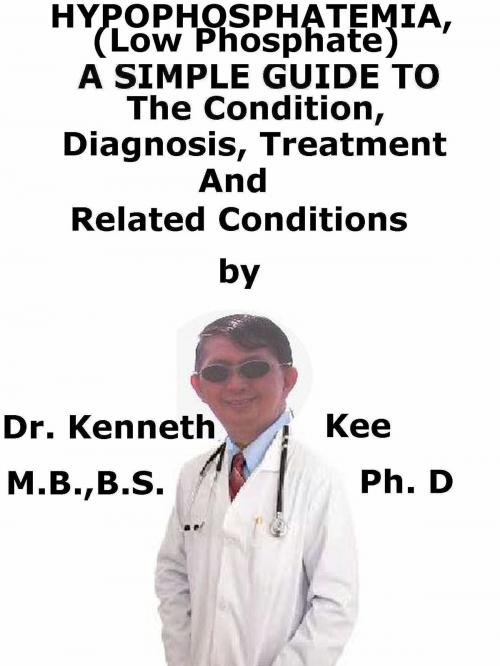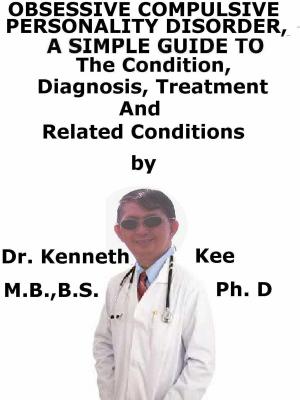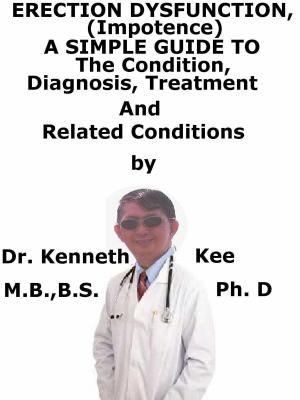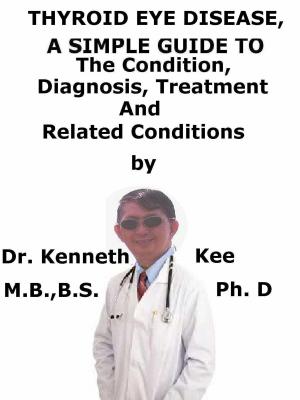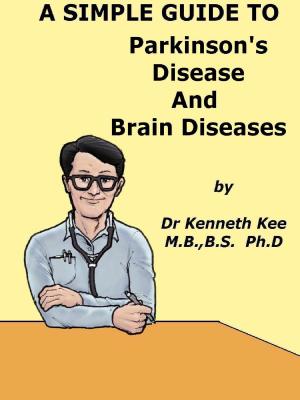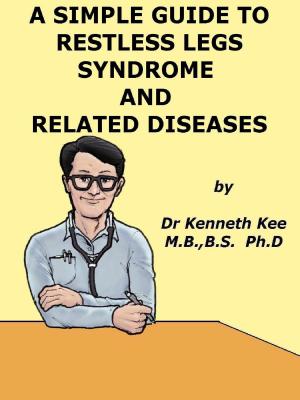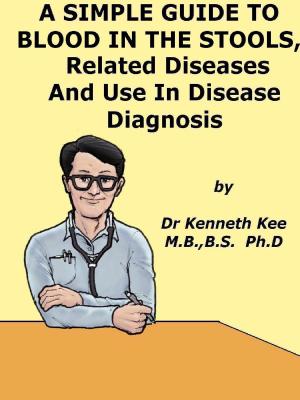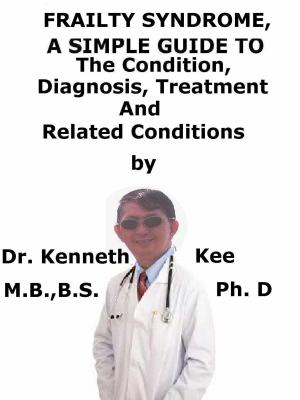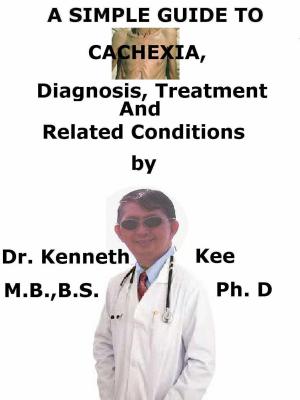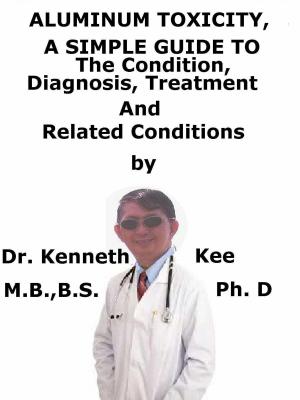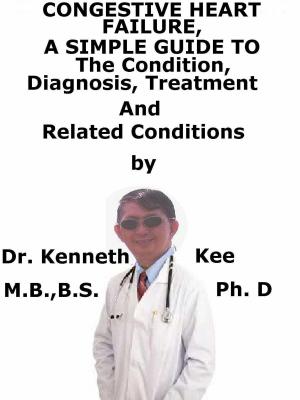Hypophosphatemia, (Low Phosphate) A Simple Guide To The Condition, Diagnosis, Treatment And Related Conditions
Nonfiction, Health & Well Being, Medical, Specialties, Internal Medicine, Endocrinology & Metabolism| Author: | Kenneth Kee | ISBN: | 9780463025611 |
| Publisher: | Kenneth Kee | Publication: | June 8, 2018 |
| Imprint: | Smashwords Edition | Language: | English |
| Author: | Kenneth Kee |
| ISBN: | 9780463025611 |
| Publisher: | Kenneth Kee |
| Publication: | June 8, 2018 |
| Imprint: | Smashwords Edition |
| Language: | English |
This book describes the Hypophosphatemia, Diagnosis, Treatment and Related Diseases
Hypophosphatemia is a medical disorder with a phosphate level of lower than 2.5 mg/dL (0.8 mmol/L).
The Phosphate is required for a wide range of cellular processes in the body.
One of the major parts forming the skeleton is phosphate that gives mineral strength to bone.
Phosphate is an essential part of the nucleic acids that make up DNA and RNA.
Phosphate attached to ATP transport the energy that is needed for all cellular functions.
Phosphate also provides a buffer in bone, serum, and urine.
The main mechanisms for the control of their activity are the addition and deletion of phosphate groups to enzymes and proteins.
The phosphate homeostasis is a highly controlled process that is required due to the wide breadth of influence of this mineral.
Causes
-
Too little vitamin D - Since phosphate is so widely available in food, dietary low phosphate is normally seen only in cases of near-total starvation.
-
Alcoholism – Alcohol can leach phosphate from the bone and result in low phosphate
-
Starvation - Low phosphate occur in starving or anorexic patients on re-feeding regimens that are high in calories but too low in phosphate
-
Overactive parathyroid gland (hyperparathyroidism) – causes the production of high calcium and conversely low phosphate
-
Diabetics who are recovering from an episode of diabetic ketoacidosis will have low phosphates
-
Patients with respiratory alkalosis will have low phosphates
Symptoms
a. Loss of appetite,
b. Anxiety,
c. Bone pain,
d. Fragile bones,
e. Stiff joints,
f. Fatigue,
g. Irregular breathing,
h. Irritability,
i. Numbness,
j. Muscle weakness,
k. Weight change.
l. Confusion
Blood studies of phosphate, calcium and magnesium can detect low phosphate.
A bone biopsy can confirm histologically and chemically the presence of low phosphate in the body.
Treatment:
Low phosphate is seldom seen in patients because it is so readily present in the food supply.
Higher levels of phosphate are normally a result of kidney disorder or by the consumption of too much nutritional phosphate and not adequate dietary calcium.
The use of Phosphates is able to treat:
-
Hypophosphatemia, low levels of phosphate in the body
-
Hypercalcaemia, high blood calcium levels
-
Calcium based kidney stones
Elemental phosphorus should be taken only under the guidance of a qualified doctor.
These inorganic phosphates that are not toxic at typical doses are used instead:
- Dibasic potassium phosphate
- Monobasic potassium phosphate
- Dibasic sodium phosphate
- Monobasic sodium phosphate
- Triphasic sodium phosphate
- Phosphatidyl choline
- Phosphatidyl serine
Doctors advise a balance of calcium and phosphate in the diet.
The treatment of hypophosphatemia that happens in hereditary disorders of phosphate wasting is with sodium phosphate and potassium phosphate salts whose use needs medical supervision.
TABLE OF CONTENT
Introduction
Chapter 1 Hypophosphatemia
Chapter 2 Causes
Chapter 3 Symptoms
Chapter 4 Diagnosis
Chapter 5 Treatment
Chapter 6 Prognosis
Chapter 7 Rickets
Chapter 8 Calcium and Phosphate Homeostasis
Epilogue
This book describes the Hypophosphatemia, Diagnosis, Treatment and Related Diseases
Hypophosphatemia is a medical disorder with a phosphate level of lower than 2.5 mg/dL (0.8 mmol/L).
The Phosphate is required for a wide range of cellular processes in the body.
One of the major parts forming the skeleton is phosphate that gives mineral strength to bone.
Phosphate is an essential part of the nucleic acids that make up DNA and RNA.
Phosphate attached to ATP transport the energy that is needed for all cellular functions.
Phosphate also provides a buffer in bone, serum, and urine.
The main mechanisms for the control of their activity are the addition and deletion of phosphate groups to enzymes and proteins.
The phosphate homeostasis is a highly controlled process that is required due to the wide breadth of influence of this mineral.
Causes
-
Too little vitamin D - Since phosphate is so widely available in food, dietary low phosphate is normally seen only in cases of near-total starvation.
-
Alcoholism – Alcohol can leach phosphate from the bone and result in low phosphate
-
Starvation - Low phosphate occur in starving or anorexic patients on re-feeding regimens that are high in calories but too low in phosphate
-
Overactive parathyroid gland (hyperparathyroidism) – causes the production of high calcium and conversely low phosphate
-
Diabetics who are recovering from an episode of diabetic ketoacidosis will have low phosphates
-
Patients with respiratory alkalosis will have low phosphates
Symptoms
a. Loss of appetite,
b. Anxiety,
c. Bone pain,
d. Fragile bones,
e. Stiff joints,
f. Fatigue,
g. Irregular breathing,
h. Irritability,
i. Numbness,
j. Muscle weakness,
k. Weight change.
l. Confusion
Blood studies of phosphate, calcium and magnesium can detect low phosphate.
A bone biopsy can confirm histologically and chemically the presence of low phosphate in the body.
Treatment:
Low phosphate is seldom seen in patients because it is so readily present in the food supply.
Higher levels of phosphate are normally a result of kidney disorder or by the consumption of too much nutritional phosphate and not adequate dietary calcium.
The use of Phosphates is able to treat:
-
Hypophosphatemia, low levels of phosphate in the body
-
Hypercalcaemia, high blood calcium levels
-
Calcium based kidney stones
Elemental phosphorus should be taken only under the guidance of a qualified doctor.
These inorganic phosphates that are not toxic at typical doses are used instead:
- Dibasic potassium phosphate
- Monobasic potassium phosphate
- Dibasic sodium phosphate
- Monobasic sodium phosphate
- Triphasic sodium phosphate
- Phosphatidyl choline
- Phosphatidyl serine
Doctors advise a balance of calcium and phosphate in the diet.
The treatment of hypophosphatemia that happens in hereditary disorders of phosphate wasting is with sodium phosphate and potassium phosphate salts whose use needs medical supervision.
TABLE OF CONTENT
Introduction
Chapter 1 Hypophosphatemia
Chapter 2 Causes
Chapter 3 Symptoms
Chapter 4 Diagnosis
Chapter 5 Treatment
Chapter 6 Prognosis
Chapter 7 Rickets
Chapter 8 Calcium and Phosphate Homeostasis
Epilogue
